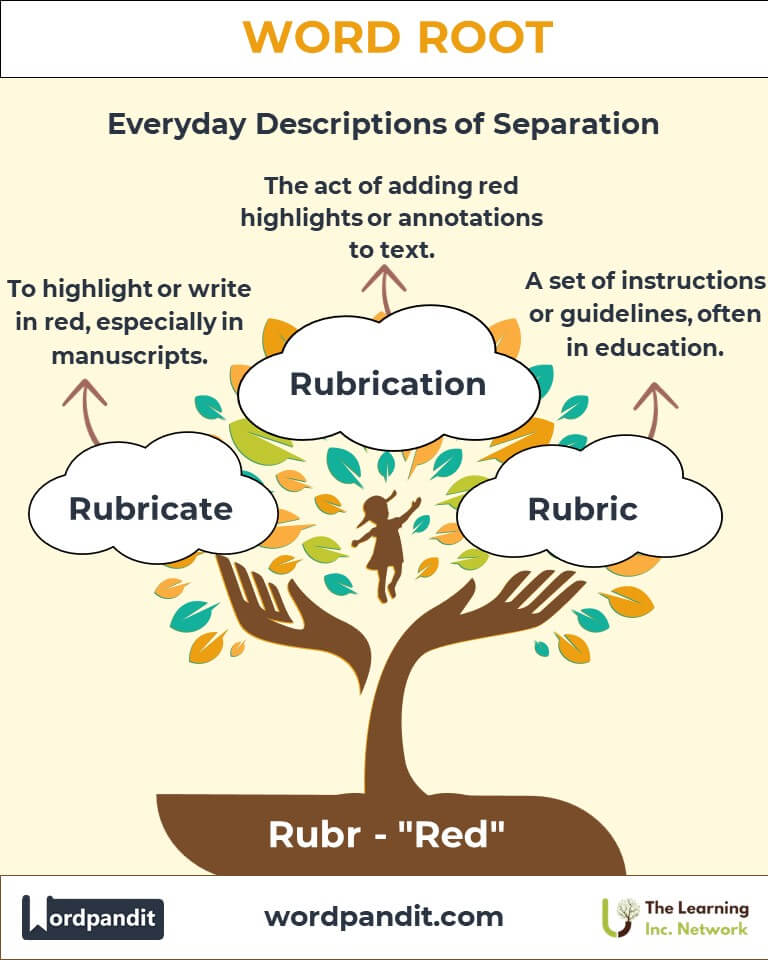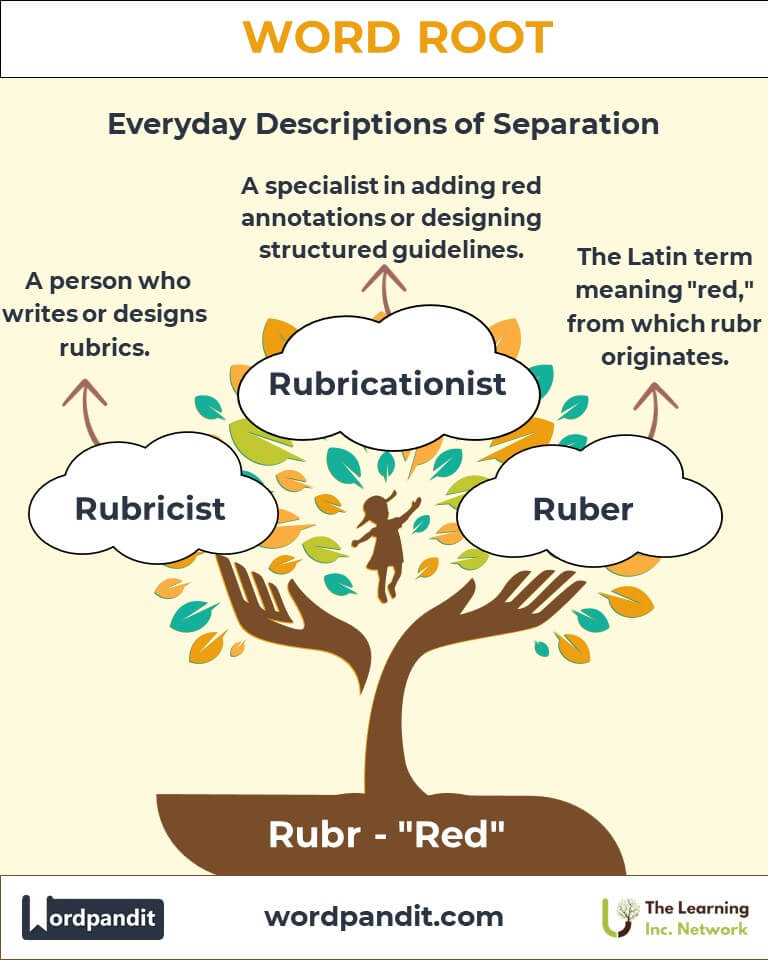Rubr: The Color of Significance in Language and Culture
Discover the vibrancy and importance of the root rubr, originating from the Latin word for "red." Found in words like "rubric" and "rubricate," this root has enriched our vocabulary with terms that highlight significance, guidelines, and the power of emphasis.

Table of Contents
- Introduction: The Essence of Rubr
- Etymology and Historical Journey
- Mnemonic: Unlocking the Power of Rubr
- Common Rubr-Related Terms
- Rubr Through Time
- Rubr in Specialized Fields
- Illustrative Story: Rubr in Action
- Cultural Significance of the Rubr Root
- The Rubr Family Tree
- FAQs about the Rubr Word Root
- Test Your Knowledge: Rubr Mastery Quiz
- Conclusion: The Living Legacy of Rubr
Introduction: The Essence of Rubr
What connects ancient manuscripts, academic guidelines, and the vibrant hue of red? The answer lies in the root rubr (pronounced ROO-ber), derived from the Latin word ruber, meaning "red." This root lends its vibrant energy to terms that denote importance, distinction, and clarity. From medieval rubrics marking liturgical instructions to modern uses in education and law, rubr illuminates language with a sense of order and emphasis.

Etymology and Historical Journey
The root "rubr" traces its origins to the Latin word ruber (red). In medieval manuscripts, headings and important instructions were written in red ink, giving rise to the term "rubric." Over time, the meaning expanded to signify any guideline, instruction, or category of importance. As the word migrated through French and English, it retained its connection to emphasis and clarity.
Mnemonic: Unlocking the Power of Rubr
Imagine a bright red underline emphasizing key points in a book. The striking color commands attention, ensuring nothing essential is overlooked.
Mnemonic Device: "Rubr brings the red of clarity, drawing focus to what’s essential."
Common Rubr-Related Terms
- Rubric (ROO-brik): A category, heading, or set of instructions.
Example: "The teacher provided a rubric to guide the students in writing their essays." - Rubricate (ROO-bri-kate): To highlight or write in red, especially in manuscripts.
Example: "The medieval scribe rubricated the headings to ensure they stood out." - Rubrication (roo-bri-KAY-shun): The act of adding red highlights or annotations.
Example: "The manuscript’s rubrication added elegance and structure to the text." - Rubricist (ROO-bri-sist): A person who writes or designs rubrics.
Example: "The rubricist ensured the evaluation criteria were clear and detailed." - Rubricationist (roo-bri-KAY-shun-ist): A specialist in adding red annotations or designing structured guidelines.
Example: "The rubricationist brought a touch of artistry to the illuminated manuscript."
Rubr Through Time
- Rubric (Medieval Period): Originally used to denote instructions written in red for liturgical texts, "rubric" gained significance as a symbol of guidance in religion and law.
- Rubricate (Modern Adaptation): The practice of emphasizing text evolved into a metaphorical usage, such as "highlighting key ideas."
Rubr in Specialized Fields
- Education: Rubric: Criteria used to assess academic work.
Application: Helps educators provide clear guidelines for evaluations. - Manuscript Studies: Rubricate: To decorate or emphasize sections of ancient texts.
Application: Preserves the artistry of medieval manuscripts. - Law: Rubric: A category or heading in legal documents.
Application: Clarifies specific sections of codes or regulations.
Illustrative Story: Rubr in Action
In a bustling medieval scriptorium, Brother Elias diligently rubricated a psalter. Using rich red ink, he highlighted the headings, ensuring that the monks could easily follow the liturgical text. Centuries later, his work inspired modern educators to create rubrics that bring clarity to academic guidelines. The enduring legacy of rubr remains a testament to the power of precision and emphasis.
Cultural Significance of the Rubr Root
The vibrant red associated with rubr has symbolized power, passion, and importance throughout history. From ancient Roman ceremonies where red marked significance, to modern grading rubrics used in classrooms worldwide, rubr continues to guide and illuminate.

The Rubr Family Tree
- Ruber (Latin): Red.
- Example: Ruby—a red gemstone.
- Ruf (Latin): Reddish.
- Example: Rufous—a reddish-brown color often describing bird plumage.
- Ros (Latin): Rose-colored.
- Example: Rosy—a term describing a reddish hue or optimistic outlook.

FAQs About the Rubr Word Root
Q: What does "rubr" mean, and where does it come from?
A: The root "rubr" means "red" and originates from the Latin word "ruber." Historically, it was associated with using red ink to mark important sections in religious or legal texts. Its metaphorical use extends to clarity and emphasis.
Q: What is a rubric in modern education?
A: A rubric is a tool educators use to evaluate and assess students' work based on specific criteria. It ensures transparency and consistency in grading by providing clear categories and descriptions of performance levels.
Q: Why were headings in medieval manuscripts written in red?
A: Red ink, or rubrication, was used to highlight titles, headings, or instructions in medieval manuscripts. The red color symbolized importance and ensured key sections stood out, guiding readers effectively through complex texts.
Q: What does "rubricate" mean?
A: Rubricate refers to the act of adding red highlights or text to manuscripts, often for decorative or functional purposes. This practice was prominent in illuminated manuscripts to emphasize specific parts of the text.
Q: How does "rubr" relate to legal terminology?
A: In law, "rubric" refers to headings or titles in legal documents that categorize sections. This usage stems from the tradition of marking important categories in red ink to aid organization and clarity.
Test Your Knowledge: Rubr Word Root Quiz
1. What does the root "rubr" signify?
2. Which term refers to a set of grading criteria?
3. What does "rubricate" involve?
4. Which root also means red?
5. What does "rubrication" describe?
Conclusion: The Living Legacy of Rubr
The root rubr symbolizes clarity, distinction, and importance. From its origins in ancient manuscripts to its modern applications in education and law, rubr continues to guide and emphasize. As language evolves, this vibrant root reminds us of the enduring power of precision and focus.












